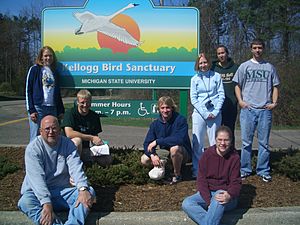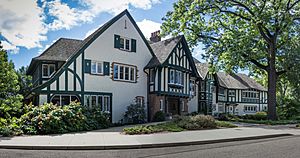Kellogg Biological Station facts for kids
Quick facts for kids Kellogg Biological Station |
|
|---|---|
| Kellogg Biological Station and Experimental forest | |
| Lua error in Module:Location_map at line 420: attempt to index field 'wikibase' (a nil value). | |
| Location | Barry County, MI |
| Nearest city | Hickory Corners, MI |
| Area | 4,100 acres (17 km2) |
| Governing body | Michigan State University, National Science Foundation |
The Kellogg Biological Station (KBS) is a large learning and research center for Michigan State University. It is located in Ross Township, Michigan, about 65 kilometers from the main campus. Many of its buildings were first built by Will Keith Kellogg, who started Kellogg's cereal. The station is named after him.
KBS covers nearly 16.5 square kilometers of land. This large area, along with nearby state lands, helps scientists study nature on a big scale. The National Science Foundation also has a special research site here. It is called a Long-Term Ecological Research site.
KBS offers classes for college students. These classes focus on topics related to biology. One program, called ELME, combines math with field work. Students spend three weeks learning math and four weeks doing hands-on science outside.
Contents
W.K. Kellogg Manor House: A Historic Home
A very special part of the Biological Station is W.K. Kellogg’s Manor House. You can find it at 3700 E. Gull Lake Drive in Hickory Corners, Michigan. This grand house sits high above Gull Lake, offering amazing views.
The Manor House: Design and Early Life
The Manor House was designed by Benjamin and Benjamin, an architectural company. It was built in 1925. This house was the summer home for W.K. Kellogg and his second wife, Dr. Carrie Staines. They lived there until 1942.
The house has a Tudor Revival style. It features special leaded glass windows and oak ceilings. The roof is made of unique Ludowici tiles. Beautiful Rookwood tiles decorate the bathrooms and fireplaces.
The Estate's Many Buildings
The estate covers 32 acres of land. It includes several other interesting buildings. There is a Carriage House and a greenhouse with a potting shed. A caretaker's cottage, a boathouse, and a real Dutch windmill are also on the property. Many lovely gardens surround these buildings.
From War to University Ownership
During World War II, Kellogg allowed the United States Coast Guard to use the house. It became a training center for new recruits. After the war, it helped injured soldiers recover. The Manor House was turned into a place for veterans to heal.
In 1951, the estate changed hands. After Mr. Kellogg passed away, he gave the Manor House and its land to Michigan State University. This gift helped create the Kellogg Biological Station. In 1998, a grant helped restore the Manor House to its original look. Today, this two-story home is used for meetings and weddings.
Kellogg Bird Sanctuary: A Haven for Birds

The Bird Sanctuary is another popular spot at the biological station. It was inspired by a similar bird refuge in Canada. This sanctuary is home to many wild birds and waterfowl. You can see trumpeter swans, Canada geese, and different kinds of ducks. Herons, cranes, and many songbirds also live here.
Helping Bird Populations Grow
The Sanctuary has played a big part in bringing back Canada goose and trumpeter swan populations. It has helped them return to the Midwest. It is also an important stop for birds traveling during their migrations. The Sanctuary also cares for captive birds of prey and game birds on its grounds.
History and Public Access
The sanctuary first opened as a refuge in 1927. It was given to Michigan State College (now Michigan State University) in 1928. The goal was to use it for research and education. The Sanctuary is still a favorite place for visitors. It offers tours, classes, and programs for everyone all year long.
Kellogg Experimental Forest: Studying Trees
The Kellogg Experimental Forest is located at 7060 N. 42nd St. in Augusta. It was started in 1932 on old farmland. This 716-acre forest is famous worldwide for its tree research. Scientists here study how to breed trees, improve tree genetics, and plant them well. They also learn how to manage tree plantations.
The Spartan Spruce: A Special Tree
Much of the research for the "Spartan spruce" happened at Kellogg Forest. This is a special hybrid tree. It combines the nice color and drought resistance of a blue spruce. It also has the softer needles and fast growth of a white spruce.
Activities at the Forest
The forest is open to the public for many activities. You can go biking, hiking, jogging, or horseback riding. Cross-country skiing is also popular in winter. The forest has over 15 miles of trails with signs to help you learn. Bow hunting, trout fishing, and picnicking are also allowed.
Gull Lake Library: A Resource for Scientists
The Gull Lake Library is a branch of the MSU Libraries. It is part of Michigan State University's W.K. Kellogg Biological Station. This library holds over 12,000 books and many bound science journals.
Supporting Research and Learning
The library receives about 150 current science magazines. Its collection helps faculty, staff, students, and visiting scientists. They use it for research in many areas. These include aquatic and terrestrial ecology, evolution, animal behavior, and agro-ecology.
Special Collections
The first director of the station, Dr. Walter F. Morofsky, was an entomologist (someone who studies insects). Because of this, the library has a large historical collection about insects. Early research at the Bird Sanctuary led to a good collection about waterfowl. When the research station became year-round in 1965, the library grew. It developed a strong collection on limnology (the study of fresh water).
Today, the library supports strong research programs. These include limnology, microbial ecology, plant ecology, agricultural ecology, fish ecology, and vertebrate behavioral ecology.


